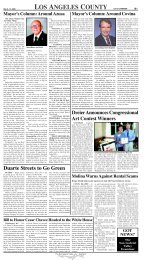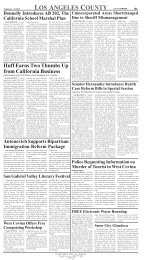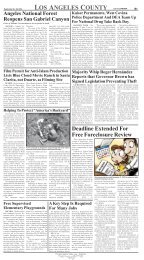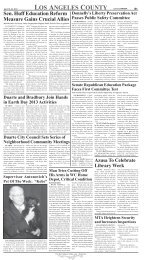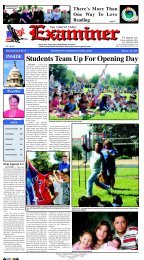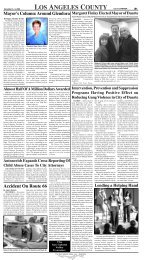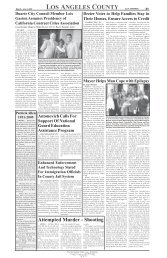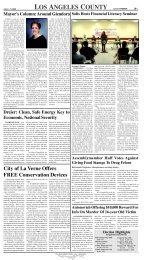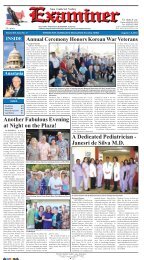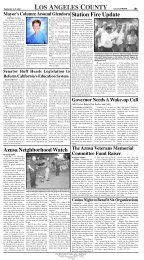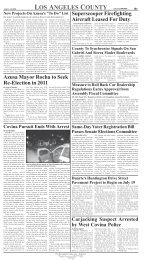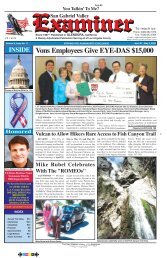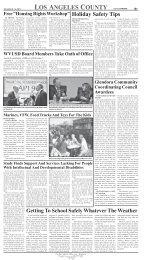B2 September 6 - 12 12.pmd - San Gabriel Valley Examiner
B2 September 6 - 12 12.pmd - San Gabriel Valley Examiner
B2 September 6 - 12 12.pmd - San Gabriel Valley Examiner
You also want an ePaper? Increase the reach of your titles
YUMPU automatically turns print PDFs into web optimized ePapers that Google loves.
B4<br />
S.G.V. EXAMINER<br />
The Importance Of This<br />
Friday's Employment Report<br />
In Friday's Jackson Hole<br />
speech, Federal Reserve Chairman<br />
Ben Bernanke made a<br />
forceful case for further largescale<br />
asset purchases, or quantitative<br />
easing. It is clear the Fed<br />
Chairman wants Quantitative<br />
Easing 3, but he still has to convince<br />
a skeptical Open Market<br />
Committee. Next Friday's employment<br />
report will be a key<br />
data point if it is going to happen<br />
this year.<br />
THE SPEECH<br />
Bernanke talked about the<br />
effectiveness of the extraordinary<br />
policy pursued by the Fed<br />
since the crisis, and in particular<br />
touted Fed analysis which<br />
found the first two QE rounds<br />
boosted GDP by three percent<br />
and boosted employment by<br />
two million jobs. The Bank of<br />
England found a proportionate<br />
result in their analysis of their<br />
own QE programs, he said. (He<br />
warned that these estimates<br />
may not be entirely accurate, as<br />
any estimate of what might have<br />
happened is just that, an estimate.)<br />
By linking QE to jobs,<br />
Bernanke forcefully reminded us<br />
of the Fed's mandate. The Fed<br />
exists to pursue stable prices<br />
and full employment.<br />
Bernanke ran through a cost<br />
benefit analysis in which he<br />
listed four major objections to<br />
QE.<br />
1. The functioning of the securities<br />
markets could be impaired.<br />
2. A further expansion of the<br />
Fed's balance sheet could undermine<br />
faith in the ability to exit<br />
accommodation, thereby increasing<br />
inflation expectations.<br />
3. If too many investors<br />
chase yield, they may take inappropriate<br />
risks, undermining<br />
financial stability. (Though he<br />
noted this is always a risk with<br />
monetary stimulus.)<br />
4. The Fed could suffer financial<br />
losses if the value of<br />
assets on its balance sheet falls.<br />
But, he said, "In light of the<br />
policy actions the FOMC has<br />
taken to date, as well as the<br />
economy's natural recovery<br />
mechanisms, we might have<br />
hoped for greater progress by<br />
now in returning to maximum<br />
employment." He blamed a still<br />
weak housing sector (despite<br />
some recent improvement), restrictive<br />
fiscal policy, especially<br />
at state and local levels and<br />
strains in credit and financial<br />
markets. He emphasized tight<br />
borrowing conditions, but failed<br />
to draw the obvious link to<br />
tough new regulations designed<br />
to prevent many of the loans<br />
common a few years ago.<br />
"As we assess the benefits<br />
and costs of alternative policy<br />
approaches, though, we must<br />
not lose sight of the daunting<br />
economic challenges that confront<br />
our nation," he said. "The<br />
stagnation of the labor market<br />
in particular is a grave concern<br />
not only because of the enormous<br />
suffering and waste of<br />
human talent it entails, but also<br />
because persistently high levels<br />
of unemployment will wreak<br />
structural damage on our<br />
economy that could last for<br />
many years."<br />
The Chairman is clearly hoping<br />
for another QE round, but<br />
the rest of the Committee is divided.<br />
Next Friday's employment<br />
report is likely to decide<br />
whether anything is done at the<br />
<strong>September</strong> meeting. Remember,<br />
too, that not taking action in<br />
<strong>September</strong> does not rule it out<br />
later. In 2010, the second round<br />
of QE hinted at in August was<br />
not announced until November.<br />
The 2010 speech<br />
The lead-up to Friday's Jackson<br />
Hole speech was punctuated<br />
by repeated reminiscences<br />
of Jackson Hole 2010. It was<br />
there Bernanke tipped his hand<br />
and signaled QE2. Or at least,<br />
that's the way many of my colleagues<br />
remember it. But it<br />
didn't really happen that way. As<br />
is so often the case when investors<br />
unravel the clues to a<br />
In In A A Nutshell<br />
Nutshell<br />
What’s up in the Economy?<br />
KEN HERMAN<br />
Economic Analyst<br />
& Former Glendora Mayor<br />
Fed action, the speech alone<br />
would not have given anything<br />
away if not for the context provided<br />
by events leading up to it.<br />
It's worth a quick review because<br />
understanding what happened<br />
two years ago provides<br />
useful context for understanding<br />
potential outcomes this year.<br />
>In July 2010, private payrolls<br />
rose 71,000, a disappointingly<br />
small gain made worse because<br />
it followed increases of<br />
just 51,000 in May and 31,000<br />
in June. Employment growth<br />
was stalling.<br />
>At the August 10 FOMC<br />
meeting, the Committee chose<br />
to reinvest the cash from mortgage<br />
principal payments (prepays)<br />
into longer-term Treasury<br />
securities. This was primarily a<br />
reaction to a report from Brian<br />
Sack at the New York Fed<br />
showing how mortgages were<br />
unexpectedly melting off the<br />
Fed's balance sheet due to low<br />
interest rates, but it was perceived<br />
as easing.<br />
>On August 24, three days<br />
before the Jackson Hole speech,<br />
Jon Hilsenrath at The Wall Street<br />
Journal published a tell-all account<br />
of the August 10 FOMC<br />
meeting. The article named<br />
names and spilled details so precise<br />
they would not even make<br />
it into the minutes published a<br />
week later. Eventually, the article<br />
spurred the Fed to adopt<br />
new communication guidelines<br />
for officials, but at the time they<br />
revealed a fractured FOMC and<br />
- for the first time - clearly revealed<br />
Bernanke as the most<br />
dovish of them all.<br />
As for the speech itself,<br />
Bernanke talked about easing in<br />
the context of what global central<br />
banks had done in the past<br />
and what the Fed still could do<br />
to help the economy. Then he<br />
said the FOMC had not decided<br />
to do anything else. He did, however,<br />
offer two conditions<br />
which would justify further easing:<br />
a credible threat of deflation<br />
or a credible threat of recession.<br />
The bond market started pricing<br />
in QE in early August, after<br />
the July employment report.<br />
The speech had very little impact<br />
on yields. But the stock<br />
market, which had been falling<br />
for two weeks, bottomed on the<br />
day of the speech and rallied<br />
through year end. So perhaps<br />
some investors did hear the<br />
speech as tipping-off the second<br />
round of QE. But it is also<br />
noteworthy that the Fed did not<br />
announce it in an FOMC statement<br />
until November, though<br />
New York Fed President Bill<br />
Dudley made it pretty apparent<br />
in an October 1 speech. Then,<br />
just two weeks later, the New<br />
York Fed surveyed the primary<br />
dealers to determine how big it<br />
should be, further tipping its<br />
hand.<br />
Bernanke's leadership of a<br />
newly-fractured board made his<br />
comments about QE in 2010 all<br />
the more potent. The market<br />
started paying much more attention<br />
to how he expressed his<br />
own views, even perhaps when<br />
he said he wasn't speaking for<br />
the Fed. Until then, there had<br />
not been a hint of dissent since<br />
the financial crisis erupted in<br />
2008. As Hilsenrath explained it,<br />
disagreement at the Fed was so<br />
heated, even the decision to reinvest<br />
mortgage prepays at the<br />
August meeting was controversial,<br />
passing only because<br />
Bernanke was masterful in managing<br />
the debate.<br />
Divergence at the Fed today<br />
If anything, the divergence<br />
FINANCIAL / CONSUMER<br />
of views within the Fed is even<br />
more pronounced today than it<br />
was two years ago.<br />
Fed hawks who opposed QE<br />
two years ago are frustrated<br />
because they believe their primary<br />
fears about QE were<br />
borne out but ignored. Richard<br />
Fisher in particular seems frustrated<br />
that QE caused massive<br />
swings in the value of the dollar<br />
and in the cost of commodities,<br />
appears to have benefited<br />
asset markets only temporarily<br />
and left the Fed with a $2 trillion<br />
bond portfolio to manage.<br />
Wall Street's understanding<br />
of the economic expansion has<br />
changed, both inside and outside<br />
the Fed. Most people, including<br />
Bernanke, expected a<br />
pretty typical recovery in 2010.<br />
No one thinks that now. To<br />
some, that is justification for<br />
more aggressive monetary<br />
policy. To others, it is proof that<br />
the very remedies we have<br />
adopted are holding back the<br />
recovery.<br />
Bernanke must convince at<br />
least some people from each of<br />
these camps to endorse QE if it<br />
is going to happen.<br />
WHY FRIDAY'S REPORT<br />
IS A BIG DEAL<br />
The August FOMC minutes<br />
showed broad support for easing<br />
unless the data turned decidedly<br />
better for a sustained<br />
period, but as James Bullard told<br />
CNBC after their release, "The<br />
minutes are a bit stale since we<br />
have some data since then that<br />
has been somewhat stronger."<br />
He went on to say that it is one<br />
thing to talk hypothetically about<br />
what it would take to justify<br />
easing. It is another altogether<br />
to actually vote for it. If data<br />
continues to be consistent with<br />
2% growth, he said, it isn't going<br />
to happen. Wall Street agrees<br />
that he is probably right.<br />
That's why the August employment<br />
report this week is<br />
such a big deal. It does not have<br />
to be strong to justify the<br />
FOMC remaining on hold. Job<br />
growth of 150k is ample to do<br />
that, despite being a disappointment<br />
to the sustainable-growth<br />
crowd. Anything between 100k<br />
and 150k is likely to result in<br />
more vigorous debate but no<br />
ease and only a sub- 100k number<br />
is likely to prod the Fed into<br />
action.<br />
Some economists say a<br />
higher unemployment rate could<br />
move the Fed. The rate bottomed<br />
in April at 8.1% and has<br />
since risen to 8.3%, part of a<br />
two-and-a-half year old pattern<br />
stretching back to the start of<br />
the recovery. Every year, the<br />
rate has fallen rapidly in the fall<br />
and winter and risen a few<br />
tenths in the spring and summer.<br />
The 2010 low was in June,<br />
the 2011 low was in March, and<br />
this year's was in April. Another<br />
tenth or two is easily dismissed<br />
as part of a seasonal issue<br />
Bernanke talked about in February.<br />
As a result, Wall Street<br />
talks about the importance of<br />
the employment report, but the<br />
really important thing is nonfarm<br />
payrolls.<br />
There were no industries that<br />
weakened by more than a few<br />
thousand in July. There are two<br />
ways to think about this. An<br />
optimist might argue the balance<br />
of change - the stuff going on<br />
at the margins - was all good.<br />
But a pessimist might point out<br />
that the number of industries<br />
which grew and the number that<br />
shrunk was about the same in<br />
July as in June. But the handful<br />
of industries which skewed<br />
from the recent norm all skewed<br />
the same way, allowing a few<br />
small improvements to add up<br />
to what looked like a big change<br />
for the better.<br />
We won't know until Friday<br />
and the August report if this<br />
pickup in activity is sustainable<br />
or, perhaps, the harbinger of a<br />
broader-based improvement.<br />
But again it raises the stakes<br />
because a weak employment<br />
report in August would signifi-<br />
I hesitate to ask for help with<br />
my current life insurance<br />
policy, 'cause I don't want to<br />
be pressured into buying<br />
something else that I don't really<br />
need. I went online, thinking<br />
I wouldn't have to deal<br />
with an agent, but that backfired<br />
- I've been flooded with<br />
calls from numerous salespeople.<br />
Can you just honestly<br />
look at my policy, give me the<br />
facts, and assure me that you<br />
won't try to sell me something<br />
I don't need?<br />
I promise - no pressure, no<br />
sales. I'll take a look at your<br />
current policy, listen to what<br />
you want, answer your questions,<br />
and supply you with all<br />
the information you'd like to help<br />
you make your own decisions.<br />
In return, I ask only one thing;<br />
that you'll be honest and up front<br />
with me.<br />
Should I get term life insurance<br />
or whole-life life insurance?<br />
And, besides cost, how<br />
do I figure how much life insurance<br />
to get?<br />
Although term insurance is<br />
typically less expensive than<br />
whole-life insurance, it's best to<br />
get quotes for both. The drawback<br />
of term life insurance is<br />
that it expires at the end of the<br />
term selected. Nowadays there<br />
are 'return-of-premium' term life<br />
insurance policies. Although<br />
these cost roughly one-third<br />
more than plain term life insurance,<br />
when you're still alive at<br />
the end of the term, you get a<br />
RANCHO CUCAMONGA -<br />
Paul Davis, a leading national<br />
provider of water, fire and mold<br />
damage clean up and restoration<br />
services for residential and<br />
commercial properties, supports<br />
National Preparedness<br />
Month to help individuals and<br />
families. "Disasters can strike at<br />
any time. It is essential to take<br />
readiness steps now for a better<br />
response later," said Tony<br />
Cunzio, owner of Paul Davis<br />
Emergency Services of Rancho<br />
Cucamonga. "The National Preparedness<br />
Month event is a<br />
great reminder for communities<br />
and businesses everywhere to<br />
always be prepared for a disaster."<br />
According to The Department<br />
of Homeland Security's<br />
Federal Emergency Management<br />
Agency's (FEMA), the<br />
program focuses on preparing<br />
for threats and hazards that pose<br />
the greatest risk to the security<br />
of the United States. It is the<br />
shared responsibility of individuals,<br />
communities, private and<br />
nonprofit sectors, faith-based<br />
organizations, along with Federal,<br />
state, and local government.<br />
cantly undermine the better one<br />
in July.<br />
LIVE LOCAL, SHOP LO-<br />
CAL - THIS IS THE TIME<br />
OUR MERCHANTS NEED US<br />
I welcome your questions and<br />
c o m m e n t s :<br />
kenherman46@hotmail.com<br />
The <strong>San</strong> <strong>Gabriel</strong> <strong>Valley</strong> <strong>Examiner</strong><br />
Julia Yoder<br />
refund of almost all the premiums<br />
you've paid. Whole-life<br />
insurance, on the other hand,<br />
might cost a little more than<br />
term life insurance, but it does<br />
not expire as long as you continue<br />
to pay your premiums.<br />
And, if you want to be covered<br />
for life, but don't want to pay<br />
premiums for life, you can obtain<br />
a quote which calculates the<br />
premiums to a certain age.<br />
Whole-life insurance can build<br />
up a cash value, accessible during<br />
your lifetime. To calculate<br />
how much insurance you'll<br />
need, estimate how much your<br />
heirs will need to maintain their<br />
lifestyle without you. Don't<br />
forget to include additional costs<br />
they may face in your absence.<br />
If you've got young children,<br />
for example, include rising<br />
costs for childcare and higher<br />
education. Add up all other<br />
sources of income: spouse's<br />
salary, pension, Social Security,<br />
or, if eligible, any other government<br />
benefits.<br />
<strong>September</strong> 6 - <strong>12</strong>, 20<strong>12</strong><br />
How can I reduce the estate<br />
tax obligations for my heirs?<br />
Life insurance is becoming<br />
more and more popular among<br />
wise investors to cover final<br />
expenses and inheritance / estate<br />
taxes. Proceeds paid to<br />
beneficiaries from a life insurance<br />
policy are income tax free.<br />
Life insurance policies are typically<br />
settled quickly (unless<br />
there are suspicious circumstances<br />
surrounding the<br />
insured's death, of course).<br />
How can I make sure that I<br />
don't outlive my retirement<br />
income?<br />
While it is good that about<br />
half of the people who are retired<br />
live beyond the average life<br />
expectancy, it also creates several<br />
risks, such as being unable<br />
to protect your standard of living,<br />
the ability to pay for increased<br />
healthcare costs beyond<br />
what Medicaid (MediCal<br />
in California) doesn't cover, losing<br />
purchasing power due to<br />
inflation, and unplanned-for<br />
long-term health care cost. In<br />
fact, that to advances in<br />
healthcare, it's not uncommon<br />
for a couple age 65 for one or<br />
both of them to live into their<br />
90's. There are investment vehicles<br />
in place that allow you to<br />
convert your rp1(k) into a lifetime<br />
income stream, and also<br />
guarantee that you will not lose<br />
any principal or interest, while<br />
at the same time, defer taxes,<br />
often over several generations.<br />
Property Damage Restoration Company<br />
Provides Safety Tips For National<br />
Preparedness Month In <strong>September</strong><br />
PASADENA - Color Me<br />
Mine will be hosting their much<br />
anticipated grand opening for<br />
their newest location in Pasadena,<br />
CA.<br />
To celebrate this arrival,<br />
Color Me Mine Pasadena will<br />
have limited time Customer Appreciation<br />
Discount from <strong>September</strong><br />
1st-8th. This special deal<br />
offers 40% off any ceramic<br />
piece in the studio! This does<br />
not include the studio fee.<br />
The Paint-It- Yourself ceramics<br />
studio boasts well over 400<br />
The program stresses the<br />
lessening of impact from natural<br />
disasters and promotes quick<br />
response to save lives, protect<br />
property, the environment, and<br />
meet basic human needs in the<br />
aftermath of a catastrophic incident.<br />
This year, the National Preparedness<br />
Month theme includes<br />
creating a family emergency<br />
plan; emergency supply<br />
kits; help for neighbors in need,<br />
and teamwork for safety. Visit<br />
www.Ready.gov for information.<br />
Paul Davis recommends the<br />
following for a Basic Emergency<br />
Kit:<br />
• Water - one gallon per person<br />
per day for at least three<br />
days<br />
• Food - at least a three-day<br />
supply of non-perishable food<br />
• Clothing - change of clothing<br />
and a sleeping bag for each<br />
person<br />
• Battery-powered or hand<br />
crank radio, a NOAA Weather<br />
Radio, extra batteries<br />
• Cell Phone and charger<br />
• Flashlight and extra batteries<br />
• First aid kit - sterile gloves;<br />
adhesive bandages; antibiotic<br />
ointment; gauze pads; iodine/alcohol<br />
pads; medical tape; pain<br />
reliever; emergency Mylar blanket;<br />
thermometer; prescription<br />
medications and supplies.<br />
• Waterproof, portable containers<br />
- for IDs, insurance policies,<br />
bank account records, site<br />
maps, employee contact, computer<br />
backup files, emergency<br />
and law enforcement information,<br />
and priority documents.<br />
Store a second set of records<br />
off-site.<br />
About Paul Davis:<br />
Paul Davis Restoration, Inc.,<br />
a subsidiary of FirstService<br />
Corporation (NASDAQ: FSRV;<br />
TSX: FSV), is a national<br />
franchisor and leading provider<br />
of restoration services for residential<br />
and commercial properties<br />
since 1966. Paul Davis also<br />
provides complete remodeling<br />
services and has franchise locations<br />
throughout North<br />
America with owners and technicians<br />
who are certified by The<br />
Institute of Inspection, Cleaning<br />
and Restoration Certification<br />
(IICRC). Visit the local<br />
office website at<br />
www.pdesranchocucamonga.com.<br />
Color Me Mine Returns to Pasadena<br />
New management greets the Pasadena community; offers paint-it- yourself ceramics<br />
ceramic items to choose from,<br />
a Design Center featuring<br />
22,000 images and over sixty<br />
colors to paint with! Customers<br />
design and paint their pieces<br />
however they like. Talented<br />
staff members are ready with<br />
painting tips. It’s so easy anyone<br />
can do it! It’s great fun to<br />
relax and paint, and even more<br />
fun to take the glazed and fired<br />
work of art and enjoy it forever!<br />
Color Me Mine Pasadena is<br />
great for birthday parties, showers,<br />
handprints, fundraisers,<br />
scouting, school programs and<br />
much more! It’s a great way to<br />
spend quality time while creating<br />
gifts and keepsakes that will<br />
last a lifetime. Everyone’s an<br />
artist at Color Me Mine!<br />
For more information on<br />
Color Me Mine Pasadena, please<br />
contact the studio at (626) 298-<br />
6765, or visit<br />
www.pasadena.colormemine.com.<br />
Studio hours are Monday-Saturday<br />
11AM-9PM and Sunday<br />
11AM-7PM.<br />
About Color Me Mine Inc.:<br />
Color Me Mine is the leader in<br />
the paint-it-yourself ceramics<br />
industry with 136 studios franchised<br />
throughout the world.<br />
Each location is an upscale artas-entertainment<br />
studio offering<br />
unfinished ceramics and other<br />
craft media. Customers enter a<br />
relaxing environment, choose<br />
one of 350 unfinished ceramic<br />
pieces, and spend an hour or<br />
two painting it to explore their<br />
own artistic vision. For more<br />
information on how it works,<br />
promotions, classes, programs,<br />
or to book a party please visit:<br />
www.colormemine.com.



